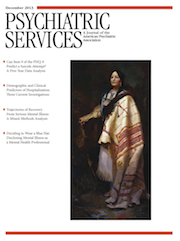Does Response on the PHQ-9 Depression Questionnaire Predict Subsequent Suicide Attempt or Suicide Death?
Abstract
Objective
As use of standard depression questionnaires in clinical practice increases, clinicians will frequently encounter patients reporting thoughts of death or suicide. This study examined whether responses to the Patient Health Questionnaire for depression (PHQ-9) predict subsequent suicide attempt or suicide death.
Methods
Electronic records from a large integrated health system were used to link PHQ-9 responses from outpatient visits to subsequent suicide attempts and suicide deaths. A total of 84,418 outpatients age ≥13 completed 207,265 questionnaires between 2007 and 2011. Electronic medical records, insurance claims, and death certificate data documented 709 subsequent suicide attempts and 46 suicide deaths in this sample.
Results
Cumulative risk of suicide attempt over one year increased from .4% among outpatients reporting thoughts of death or self-harm “not at all” to 4% among those reporting thoughts of death or self-harm “nearly every day.” After adjustment for age, sex, treatment history, and overall depression severity, responses to item 9 of the PHQ-9 remained a strong predictor of suicide attempt. Cumulative risk of suicide death over one year increased from .03% among those reporting thoughts of death or self-harm ideation “not at all” to .3% among those reporting such thoughts “nearly every day.” Response to item 9 remained a moderate predictor of subsequent suicide death after the same factor adjustments.
Conclusions
Response to item 9 of the PHQ-9 for depression identified outpatients at increased risk of suicide attempt or death. This excess risk emerged over several days and continued to grow for several months, indicating that suicidal ideation was an enduring vulnerability rather than a short-term crisis.



